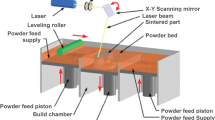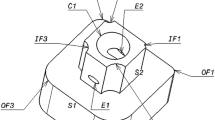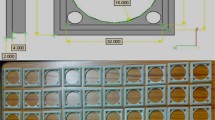Abstract
Laser ablation is a high-efficiency, high-precision, and very flexible process for removal material which has been widely used in many industrial applications, such as semiconductor, electronic, aerospace, and other fields. With the development of modern manufacturing industry, the application of laser ablation technology needs to be expanded to meet the growing demand of three-dimensional processing. A method named laser ablation by projective galvanometer scanning (LPAGS) can effectively apply laser ablation technology to three-dimensional processing field. For three-dimensional processing, the machining results are strongly affected by the processing parameters. Optimal selection of process parameters is highly critical for successful material removal and achieving high surface quality. In this paper, the effects of processing parameters including laser incident angle, scan speed, laser power, and fill spacing on ablation depth and surface roughness were studied in detail. An orthogonal experiment based on Taguchi method was used to determine the optimal processing direction for minimizing the surface roughness and maximizing the milling depth. The typical structural patterns were fabricated on surface of aluminum by using a LPAGS processing system. Signal/noise ratio (S/N ratio) and analysis of variance (ANOVA) were employed to investigate the optimal levels of processing parameters. The analysis results indicated that laser incident angle and laser power have significant effect on the ablation depth with 48.02 and 39.67% contribution, and laser incident angle, laser power, and scan speed are most significant parameters with 40.88, 24.66, and 30.16% contribution on surface roughness.
Similar content being viewed by others
References
Meijer J (2004) Laser beam machining (lbm), state of the art and new opportunities. J Mater Process Technol 149(1–3):2–17
Dubey AK, Yadava V (2008) Laser beam machining—a review. Int J Machine Tools & Manuf 48(6):609–628
Heyl P, Olschewski T, Wijnaendts RW (2001) Manufacturing of 3d structures for micro-tools using laser ablation. Microelectron Eng 57–58(9):775–780
Petkov V, Vladev P (2002) Laser milling. Proceedings of the institute of mechanical engineers, part B. J Eng Manuf 216(5):657–667
Petkov, P. V., Pham, D. T., Dimov, S. S., & Dobrev, T. (2004). Laser milling as a ‘rapid’ micromanufacturing process. Proceedings of the institute of mechanical engineers, part B. Journal of engineering manufacture, 218(1), págs. 1–7
Saklakoglu IE, Kasman S (2011) Investigation of micro-milling process parameters for surface roughness and milling depth. Int J Adv Manuf Technol 54(5):567–578
Campanelli SL, Ludovico AD, Bonserio C, Cavalluzzi P, Cinquepalmi M (2007) Experimental analysis of the laser milling process parameters. J Mater Process Technol 191(1–3):220–223
Kaldos A, Pieper HJ, Wolf E, Krause M (2004) Laser machining in die making—a modern rapid tooling process. J Mater Process Technol 155–156(1):1815–1820
Campanelli SL, Casalino G, Contuzzi N (2013) Multi-objective optimization of laser milling of 5754 aluminum alloy. Opt Laser Technol 52(11):48–56
Overmeyer L, Duesing JF, Suttmann O, Stute U (2012) Laser patterning of thin film sensors on 3-d surfaces. CIRP Ann Manuf Technol 61(1):215–218
Diaci J, Bračun D, Gorkič A, Možina J (2011) Rapid and flexible laser marking and engraving of tilted and curved surfaces. Opt Lasers Eng 49(2):195–199
Wang X, Duan J, Jiang M et al (2017) The international journal of advanced manufacturing technology. doi:10.1007/s00170-017-0413-z
Pedder, J. E. A., & Holmes, A. S. (2006). A study of angular dependence in the ablation rate of polymers by nanosecond pulses. Proc Spie, 61061B-61061B-9
Wang C, Zeng X (2007) Study of laser carving three-dimensional structures on ceramics: quality controlling and mechanisms. Opt Laser Technol 39(7):1400–1405
Yuan, G. F., & Zeng, X. Y. (2003). Experimental study of laser milling on marble. Chinese J Lasers
George DS, Onischenko A, Holmes AS (2004) On the angular dependence of focused laser ablation by nanosecond pulses in solgel and polymer materials. Appl Phys Lett 84(10):1680–1682
Savaş Ö, Kayikci R (2007) Application of taguchi’s methods to investigate some factors affecting microporosity formation in a360 aluminium alloy casting. Mater Des 28(7):2224–2228
Kasman Ş, Saklakoglu IE (2012) Determination of process parameters in the laser micromilling application using taguchi method: a case study for aisi h13 tool steel. Int J Adv Manuf Technol 58(1):201–209
Lin YC, Chen YF, Wang DA, Lee HS (2009) Optimization of machining parameters in magnetic force assisted edm based on taguchi method. J Mater Process Technol 209(7):3374–3383
Author information
Authors and Affiliations
Corresponding author
Rights and permissions
About this article
Cite this article
Wang, X., Duan, J., Jiang, M. et al. Investigation of processing parameters for three-dimensional laser ablation based on Taguchi method. Int J Adv Manuf Technol 93, 2963–2974 (2017). https://doi.org/10.1007/s00170-017-0749-4
Received:
Accepted:
Published:
Issue Date:
DOI: https://doi.org/10.1007/s00170-017-0749-4




